

IH EAE- Institut für Bildungsmanagement und Bildungsökonomie der Pädagogogische Hochschule Zug. The International Handbook of Evaluation and Assessment in Education (Springer) is now calling for chapter proposals.

This international handbook is edited by Prof. Dr. Stephan Huber, the Head of the Institute for the Management and Economics of Education (IBB) at the University of Teacher Education Zug, Switzerland. The book will be published by Springer: Aims and Scope This handbook aims to bring together chapters by distinguished authors from around the world. World of Fun. Rubric Design: Assessing Learning Outcomes. At Champlain College, hands-on learning is highly valued, and more often than not, instructors assign performance-based tasks, rather than exams, to advance and assess student learning.

Performance-based assignments call for performance-based or "authentic" assessments; rubrics, which evaluate the series of tasks or criteria that are needed to produce a quality finished product, are the appropriate tools for evaluating these work products. Rubrics, if used well, can be powerful tools for teaching and assessment. A well written rubric does more than make a teacher's expectations clear to the student; it defines quality and proficiency.
This is helpful not only to the student for the purposes of project planning and self-evaluation; it helps an instructor provide intelligible feedback. Furthermore, by providing clear definitions of proficiency for all the necessary criteria, a rubric constitutes a reliable tool when multiple assessors are rating student work. 1. Examples. To Assessment Alley. Gmail - Free Storage and Email from Google. Basic Concepts in Item and Test Analysis. Basic Concepts in Item and Test Analysis Susan Matlock-Hetzel Texas A&M University, January 1997 Abstract When norm-referenced tests are developed for instructional purposes, to assess the effects of educational programs, or for educational research purposes, it can be very important to conduct item and test analyses.

These analyses evaluate the quality of the items and of the test as a whole. Paper presented at the annual meeting of the Southwest Educational Research Association, Austin, January, 1997. Formative assessment - Prezentări Google. Cambridge English. Revised Cambridge English: Young Learners tests – an overview. Linksammlung für ENGLISCH. Teachers’ Responses to Feedback from Evaluators: What Feedback Characteristics Matter? Basic Concepts in Item and Test Analysis. Statistical analyses for test fairness. In earlier writings (Kunnan 2000, 2004), I presented an ethics-inspired rationale for my Test Fairness Framework (TFF) with a set of principles and sub-principles.
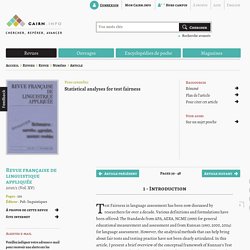
The principles use a mixed deontological system which combines both the utilitarian and deontological systems. Frankena suggests reconciling the two types of theories by accepting the notion of rules and principles from the deontological system but without its rigidity and by using the consequential or teleological aspect of utilitarianism but without the idea of measurement of goodness, alleviation of pain, or to bring about the greatest balance of good over evil. Thus, two general principles of justice and beneficence and sub-principles are articulated as follows: Principle 1: The Principle of Justice: A test ought to be fair to all test takers, that is, there is a presumption of treating every person with equal respect. The TFF views fairness in terms of the whole system of a testing practice not just the test itself. 1.
Linksammlung für ENGLISCH. Berufsbildende Schulen. RIS - Gesamte Rechtsvorschrift für Bildungsstandards im Schulwesen - Bundesrecht konsolidiert, Fassung vom 13.09.2016. Anlage Bildungsstandards und Kompetenzmodelle.
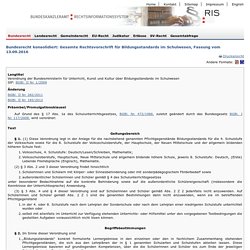
RIS - Gesamte Rechtsvorschrift für Prüfungsordnung BMHS und Bildungsanstalten - Bundesrecht konsolidiert, Fassung vom 13.09.2016. RIS - Gesamte Rechtsvorschrift für Prüfungsordnung AHS - Bundesrecht konsolidiert, Fassung vom 13.09.2016. Themenfestlegung, Inhalt und Umfang der vorwissenschaftlichen Arbeit § 8. (1) Die Themenfestlegung hat im Einvernehmen zwischen der Betreuerin oder dem Betreuer der vorwissenschaftlichen Arbeit und der Prüfungskandidatin oder dem Prüfungskandidaten im ersten Semester der vorletzten Schulstufe zu erfolgen.
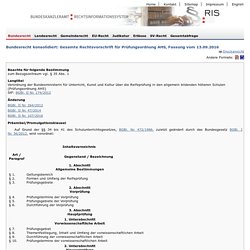
Writing performances (BHS) – Universität Innsbruck. Testing Listening Comprehension: The Listening Comprehension Construct. Testing Listening Comprehension (1 of 4 in a series) The Listening Comprehension Construct Testing listening comprehension is a complex undertaking.
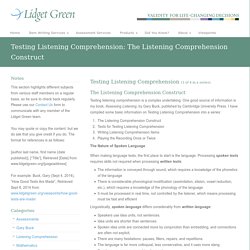
One good source of information is my book, Assessing Listening, by Gary Buck, published by Cambridge University Press. I have compiled some basic information on Testing Listening Comprehension into a series: The Listening Comprehension ConstructTexts for Testing Listening ComprehensionWriting Listening Comprehension ItemsPlaying the Recording Once or Twice. Course handbook for promoting sustainable dxcellence in English language testing and assessment - University of Bedfordshire Repository.
Formative E-Assessment in Plenary Lectures - Nr 01 - 2012 - Nordic Journal of Digital Literacy - Idunn - tidsskrifter på nett. Introduction This article focuses on the question of whether, and eventually how, audience response systems (ARS) and feedback clickers (TurningPoint®) can be used to overcome some of the challenges experienced by lecturers in large plenary lectures at universities.

New international as well as national policies demand that student curricula in Norway must be more specifically formulated around learning outcomes as well as the use of information and communication technology (ICT) as a tool in teaching and student learning processes. However, a recent report by the Ministry of Education and Research concludes that we have access to a great deal of information about intended learning outcomes in the Quality Framework of Higher Education (Ministry of Knowledge (MOK), 2010), but that we have limited knowledge about teaching quality and teaching methods in higher education.
Equally importantly, we know very little about students’ subjective and objective learning outcomes. Background. Assessment for learning - Research summaries. The effective promotion of assessment for learning requires teachers to recognise that feedback is a two-way process.
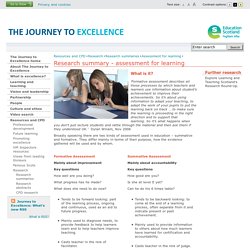
Teachers not only need to find ways to give more effective feedback to learners, they must also find ways of receiving better feedback from learners. This points to a number of practical areas for development. Quality of classroom dialogue Receiving better feedback from learners about what they have understood or can do, and the strategies they are using, is an essential part of good teaching. Getting inside a learner’s head to clarify what learning has taken place, to identify what learning difficulties are being experienced and to introduce future tasks, is one of the biggest challenges for classroom teachers. The way that they ask questions;the way that they respond to pupils;classroom routines; andthe nature of the tasks and activities that learners undertake. B6: Leistungsfeststellung und Leistungsbeurteilung. Ferdinand Eder, Georg Hans Neuweg und Josef Thonhauser Die „Leistungsbeurteilungsverordnung“ (LBVO)[1] unterscheidet zwischen Leistungsfeststellung als einem Vorgang des Messens und Leistungsbeurteilung als einem Vorgang des Bewertens der gemessenen Leistungen.
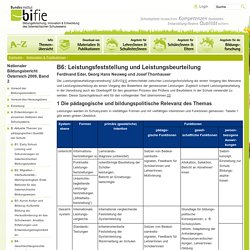
Zugleich scheint Leistungsbeurteilung in der Verordnung auch als Oberbegriff für den gesamten Prozess des Prüfens und Beurteilens in der Schule verwendet zu werden. Startseite. Answer the Question Frames. Sample Exit Tickets. Classroom Assessment & Feedback. Listen: Comprehension progression. Understand discourse on a range of topics beyond everyday contexts and immediate experiences listen for the gist or for specific information in a wide range of oral texts use comprehension strategies selectively and flexibly use a range of strategies when comprehension breaks down in different listening situations.
Listeners get the gist of a wide range of complex connected discourse in a variety of situations. Topics may include those associated with personal, community, work and education settings. Self-Directed Learning: Learning Contracts. Learning contracts are argued to be the most important tool for successful and positive independent study experiences for both students and advising faculty members. Learning contracts should be constructed by the student and reviewed by the advising faculty member for constructive feedback and suggestions for modification. A final version of the learning contract should be signed by both student and advising faculty member.
The contract then serves as an outline for the independent study units and a tool to aid evaluation. Learning Contracts. Looking for Strategies and Activities? Click Here! What is a learning contract? A learning contract is an agreement established between a student and the teacher; it sometimes involves the student’s parents. The contract specifies concrete learning and/or behavioural objectives for the student that all parties agree need to be achieved.
The contract also specifies: the goals of the contract the obligations of each party to the contract the time frame within which the terms of the learning contract are to be fulfilled the basis on which it will be determined that the conditions of the contract were met Why create a learning contract? There may be many reasons that teachers set up learning contracts with their students, but the end goal always involves an improvement in some aspect of a student’s performance at school. Learning Contracts. Learning contracts are agreements between a teacher (or teaching team) and a learner (or occasionally a group of learners). They normally concern issues of assessment, and provide a useful mechanism for reassuring both parties about whether a planned piece of work will meet the requirements of a course or module: this is particularly valuable when the assessment is not in the form of a set essay title, or an examination.
This page concentrates on the commonest application, relating to assessment. Obviously, there are occasions on which the contract is much wider, specifying what the client/learner wants to learn; these are more common in consultancy agreements and go beyond the purview of this site, which is principally concerned with the institutional delivery of learning. However, there is more to the principle of the learning contract than a convenient administrative device. Merely using the technique, however, does not automatically bring about this ownership and involvement.
Edutopia. Language shapes our worldview. The narratives we hear around us influence our perceptions and understandings. Take Carol Dweck's concept of fixed versus growth mindset. One of the primary tools for fostering a growth mindset is changing how we talk about learning, from how we give feedback to how we address failure. Dweck's work shows that simple shifts in language of praise and feedback can hold immense power in children's view of themselves and of learning.
We should harness this same power to better support our students who struggle with mental health challenges on a daily basis. One in five children between age nine and 17 have mental health challenges that impair their daily functioning. PRO-ED Inc. Price: $345.00 Ages:4-0 to 8-11Testing Time:30 minutes to 1 hourAdministration:Individual The Test of Language Development-Primary: Fourth Edition (TOLD-P:4) assesses spoken language in young children.
It is well constructed, reliable, practical, research-based, and theoretically sound. Professionals can use the TOLD-P:4 to (1) identify children who are significantly below their peers in oral language proficiency, (2) determine their specific strengths and weaknesses in oral language skills, (3) document their progress in remedial programs, and (4) measure oral language in research studies. The 6 Types Of Assessments (And How They're Changing) British Council - Word Family Framework. About What is the Word Family Framework (WFF)? The WFF is a searchable resource for teachers and learners of English that consists of over 22,000 vocabulary items arranged according to six levels aligned to the Common European Framework of Reference. What can the WFF be used for?
The WFF can be used by institutions, teachers and learners to construct target vocabularies for individual learning, syllabus and lesson planning, materials design and exam preparation. Canadian Language Benchmarks. The Canadian Language Benchmarks (CLB) comprise a 12-point scale of task-based language proficiency descriptors used to guide the teaching and assessment of ESL learners in Canada. Like the Common European Framework of Reference for Languages and the ACTFL Proficiency Guidelines, the Canadian Language Benchmarks describe ESL learners' successive levels of communicative achievement. WebABLLS Online Assessment for Children with Autism.
The Analysis of Verbal Behavior. The Analysis of Verbal Behavior (TAVB) is a scientific journal that was established in 1982 as a peer-reviewed psychology journal. Assessment of basic language and learning skills. Common European Framework of Reference for Languages. Qu_Mod6.pdf. Doc0a15.pdf. Ropean Association for Language Testing and Assessment. About WebCEF. As a registered user of the Assessment tool you can create, upload, rate and comment on video and audio samples.
English. Www.pasadena.edu/resources/online/online_124.pdf. First Moodle rubrics for pronunciation practice. Plugins directory: Online Audio Recording. Advanced grading methods. Advanced grading methods. Examples: tasks: high school: foreign languages (spanish level 3 - debate oral evaluation rubric) ORAL PRONUNCIATION TEST rubric - F6W345: RCampus. Pronunciation Assessment rubric - P98X99: RCampus. Www.ielts.org/PDF/vol12_report1.pdf. Cowgill.ling.yale.edu/sra/phonology.htm. Www.fikkert.com/fikkert_glot.pdf. Second-language phonology. Phonological development. Table 4 - Phonetic Development. Ati.pearson.com/downloads/Helping-Students-Understand-Assessments-by-Jan-Chappuis.pdf. Steve Chappuis - Assessment Training Institute. Www.ets.org/Media/Research/pdf/CEF_Mapping_Study_Interim_Report.pdf. Time needed to reach language level - Google Search. Casls.uoregon.edu/pdfs/tenquestions/TBQHoursToReachIH.pdf. How Long Does it Take to Become Proficient? - Language Testing International. WELCOME TO THE WEBSITE FOR THE EUROPEAN LANGUAGE PORTFOLIO.
Www.coe.int/t/dg4/education/elp/elp-reg/cefr_scale_EN.asp? Rubrics.
B1 level English language practice tests. Multiple Measures:The Quest for Quality. Www.islpr.org/PDF/ISLPRoverview.pdf. Scale Levels. Guttman scale. ILR. Criterion-referenced Language Testing. Criterion- and Standards- Referenced Tests. Criterion-referenced test. Criterion-referenced assessment.